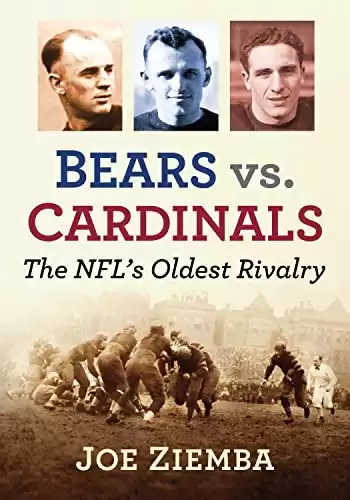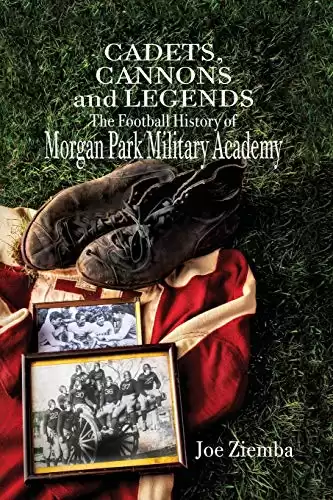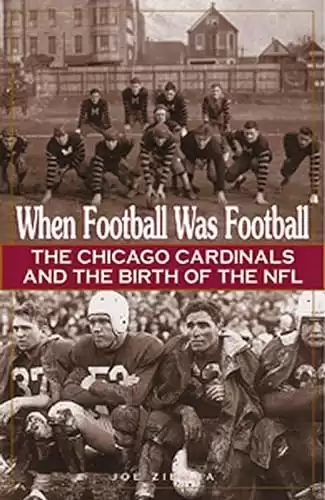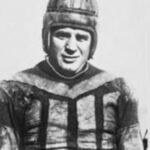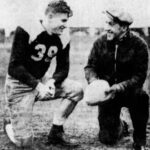Let’s set the stage…
It was a warm November afternoon on the Chicago lakefront, but over 120,000 people were crammed into Soldier Field for the big football game.
120,000!
Were the Bears playing? Nope.
Or perhaps the Chicago Cardinals? Nah.
Maybe Notre Dame? No—none of the big boys from the area were on the field, but instead, it was just a couple of local high school teams. What type of game could attract such a huge audience to witness a bunch of kids playing football?
On this episode of “When Football Was Football,” we’ll take a break from covering professional football and journey back to 1937 for a celebration of one of Chicago’s most prominent annual sporting events: the Prep Bowl.
Each year, the high school season in the city would conclude with the enormously popular clash between the champions of the Chicago Catholic League and the Chicago Public League. Things have changed over the years, of course, but for decades the Prep Bowl easily garnered one of the largest attendances of any sporting competition in the United States.
It all began informally and inconspicuously in 1927, when Mt. Carmel of the Chicago Catholic League eased past Schurz 6-0 for city bragging rights before 50,000 attendees. DePaul Academy fell to Tilden 12-0 in 1928, but then no game was played until 1933 except for Mt. Carmel’s 44-6 loss to Harrison in 1931. In 1934, under the guidance of Chicago Mayor Edward Kelly, the game itself was formally established as an annual event pitting the champions of the two leagues against each other.
Known then as the “Mayor’s Charity Game,” the contest served not only as an attractive sporting event, but also provided an opportunity to generate revenue for charitable organizations in the Chicago area.
DeCorrevont Scored 57 Points in Single Game!
Since the city of Chicago was basically sponsoring the game, ticket prices were very low (50 cents to $1.00) and city employees, such as firemen, were encouraged to hawk the tickets with the understanding that it was acceptable to purchase a ticket, even if there was no intention of attending the game. This fund-raising aspect of the game was clearly important.
But in 1937, there was an added interest with the magical presence of halfback Bill DeCorrevont in the Austin High School backfield, the Public League champions. The 5-10, 180 lb. senior was perhaps the most celebrated high school athlete in the country at the time. The elusive runner scored an unbelievable 39 touchdowns that season and wire services around the country eagerly shared his exploits on the gridiron.
Among DeCorrevont’s significant accomplishments was the total of 57 points he scored in an early season 93-0 romp over McKinley High School. In that blow-out, DeCorrevont carried only ten times, but scored on nine of those attempts. With the addition of his three extra-point kicks, DeCorrevont accumulated an amazing 57 points on the day!
The 1938 Austin yearbook fondly reported on that historic McKinley game: “In the last quarter alone, the team scored 54 points for another record. Victory was all the more remarkable in that the first team played only two-quarters of the game.”
Austin High School was undefeated with an 8-0 record heading into the championship battle with the Catholic League’s Leo High School on November 27, 1937. Aside from its 93-point destruction of McKinley High School, Austin demonstrated its offensive firepower in romps over Farragut (47-0), Marshall (61-6), and Steinmetz (32-0). Austin then reached the overall city championship game by defeating Senn 14-6 in the Public League title tilt. Although the Senn victory represented the closest winning margin of the year for Austin, it was also the second straight Public League championship for the school.
On the other (or “Catholic”) side of the field, Leo High School was also 8-0 if one forgets a season-opening 7-6 “practice” game loss to Loyola. Leo possessed its own backfield star in left halfback John Gavin, the leading scorer in the Catholic League, who was also named to the All-Catholic and All-City honor squads at the end of the 1937 season. Coached by Aloysius L. “Whitey” Cronin, Leo previously found its way to the city title game in 1934 and 1935, losing both games to Lindbloom by identical 6-0 scores.
In 1937, Leo captured its fourth straight south section crown in the Catholic League by beating De LaSalle 22-6 on November 7, then needed to patiently wait for the north section race to sort itself out. Eventually, St. George emerged as the north contender, and in the battle for Catholic League supremacy, Leo prevailed with a tough 6-0 victory. This qualified Leo to meet Austin in the city championship battle.
Gavin vs. Willie
All of this prompted the Chicago Tribune to happily preview the city title game: “Johnny Gavin and Leo vs. Willie DeCorrevont and Austin. That will be the scenario next Saturday at Soldier Field when the champions of the City and Catholic leagues meet in the annual interleague battle for Chicago’s Own Christmas benefit, sponsored by Mayor Kelly.”
The stage was set for an engaging match between the two most powerful, and undefeated, prep clubs in the city. And in those days before television and the internet, just about everybody in Chicago was anxious to personally witness the highly anticipated game. There was no lack of coverage in the numerous local newspapers, where the tremendous accomplishments of DeCorrevont were recounted almost daily.
The importance of the outcome was equally important to both the public and parochial followers of the game of football in Chicago. Still, football wasn’t all that big of a deal to DeCorrevont as he noted years later: “It’s funny. Now (in 1987), football seems to be getting more and more important to people with each passing day. It didn’t seem so important at the time.”
In 1937, Soldier Field looked much different than it does today. Although it included seating for approximately 72,000, additional seating or standing room could be accommodated on the sloping “open” north end of the field itself—and that is where thousands found themselves on game day. In addition, hundreds more could observe the action by standing on the track surrounding the football field.
No-Shows Attended The Game
According to local newspapers, the gates to Soldier Field were opened on November 27 nearly two hours before the 1:30 pm kickoff time.
The lines outside the gates were long for those waiting to enter. As fans continued pouring in, it was clear the ambitious ticket-sellers sent out by Mayor Kelly had done their job very well, except that the thousands of expected “no-shows” did indeed intend to be present for the game on this warm late autumn day. With the temperature hovering above the 50-degree mark, it was a near-perfect afternoon for football!
As a 1,000-member student band composed of musicians from the city’s schools initiated the festivities with a resounding rendition of the “Star Spangled Banner” at 1:00 pm, the march of attendees into the stadium was relentless. By 1:30, Soldier Field was filled and additional attendees squeezed into aisles while others stood seven deep all around the top of the U-shaped structure.
While no “official” attendance was recorded, Evan Kelly of the Chicago Park District indicated that the crowd was even bigger than the 112,000 who witnessed the 1926 Army-Navy game at Soldier Field. With estimates running as high as 125,000, and as low as 110,000, the Chicago Tribune announced that the Park District guessed that the likely number was 120,000.
The Big Thing Was That Crowd - 120,000 People!
Thirty years later, Bill Heiland, the Austin High School coach, recalled the presence of the huge crowd at Soldier Field in an interview with the Chicago Tribune: “The big thing was that crowd—120,000 people.
People were sitting all the way up the slope, and there were thousands of them on the track (which circled the football field). I didn’t really notice the crowd until it was all over, and then when I saw them it was quite a thrill.”
And then in 1987, years after the game DeCorrevont himself remembered the impressive audience in an interview with the Associated Press: “I remember going back for a punt and seeing people standing all along the edge of the bowl, two or three deep on the ledges, kind of outlined by the sky.”
He then added in a separate comment to the Chicago Tribune: “I couldn’t imagine there would be this many people coming to see a high school football game. All I could say to myself was, ‘Don’t louse things up now.’”
Justification For DeCorrevont's Yards of Press
DeCorrevont failed to “louse” things up. In fact, his performance was superlative! Even the Los Angeles Times reported on the game stating: “The game served as justification for 19-year-old DeCorrevont’s yards of press notices.” The South Bend Tribune added: “Most of the crowd, the largest ever to see a high school game, had turned out to see a high-scoring DeCorrevont. He rewarded them.”
Austin rambled to an easy 26-0 victory over Leo High School, behind the spectacular performance of DeCorrevont, as reported by the Tribune: “Bill DeCorrevont, one of the most widely publicized prep stars in history, was suffering from a charley horse yesterday and was made nervous by a record crowd announced at 120,000.
So, all the blond star from Austin did was score three touchdowns and pass into the end zone for the fourth one. These deeds were the climaxes of the many sterling maneuvers that enabled Austin’s Maroons to whip Leo’s Lions 26-0 in a grand game which enriched Chicago’s Own Christmas Benefit Fund by $110,000.”
After a scoreless first quarter, DeCorrevont broke the scoring drought by dancing away for a 47-yard touchdown run behind the blocking of talented tackle John Starkey. After the extra point by Alf Bauman, Austin led 7-0. Shortly thereafter, an intercepted pass by Austin resulted in a second TD by DeCorrevont, this time on a one-yard plunge. Once again, Bauman booted the extra try and Austin extended its advantage to 14-0 at the halfway mark.
Austin struck again in the third stanza when DeCorrevont raced in from the three to move his team ahead 20-0. The final blow occurred in the fourth quarter when DeCorrevont tossed a 25-yard scoring pass to Sonny Skor resulting in a 26-0 victory for Austin. DeCorrevont picked up an even 100 yards on 16 carries for the day and also intercepted a pass deep in his own territory that thwarted a long Leo offensive drive.
The Dogged Fight of the Leo Boys
Writer Edward Burns of the Tribune argued that the real story was not just the overwhelming attendance, but the quality of play on the field by the two squads: “Whether the crowd was 90,000 or 130,000, the customers were all entertained, not only by Austin’s brilliant performance, but by the dogged fight of the Leo boys, who kept right on trying after their dreams of victory had been rudely jolted in the second quarter.”
While disappointed at another failure to capture the city title in 1937, the Leo club was honored in the school’s yearbook which stated: “The Austin squad had too much power and one Bill DeCorrevont, a combination that was too much for the Lions. Although outweighed and severely bruised, every Leo man that entered the game fought with everything he had until the final whistle sounded.”
The Lions, however, would bounce back with city championship game wins in 1941 and 1942, both over Tilden. The 1941 contest drew a crowd of 95,000 and Leo was named as the mythical high school national champion for that season. For Austin, the schedule was not yet concluded. The school accepted a challenge from Jackson High School in Tennessee to battle for national high school supremacy. In front of 5,000 fans at Crump Stadium in Memphis on December 11, 1937, Austin battled the freezing elements to defeat Jackson 13-0 to complete an undefeated (10-0) campaign.
DeCorrevont scored the first touchdown for Austin on a 37-yard run, but then injured his shoulder in the second period and played sparingly after that. It was a joyful end to the year as noted by the Austin yearbook: “Two weeks later [after the Leo game], the Maroons migrated southward to wind up a glorious season and annex the mythical national championship defeating the south’s titleholders from Jackson, Tennessee 13-0.”
DeCorrevont Offered As High As $2,000 Per Season
So how did the pros in 1937 compare attendance-wise with the high school juggernaut known as Austin High School? After the Austin game brought over 120,000 to Soldier Field on November 27, 1937, the Bears drew just 4,188 a day later at Wrigley Field!
For Bill DeCorrevont, his football career was just beginning. His collegiate recruitment was intense with Collyer’s Eye reporting that DeCorrevont was “sought by virtually every big-time institution in the land, and reputedly offered as high as $2,000 per season by several Pacific Coast schools. DeCorrevont would be assured a lucrative job in Warner Brothers movie studio, plus $250 per game, to enroll at Troy [USC].”
Instead, DeCorrevont decided to stay at home and enrolled at Northwestern University in north suburban Evanston where he enjoyed a productive career. One of his better games was when he scored two touchdowns in a 51-3 win over Kansas State in 1941 and partnered with future pro football hall of famer Otto Graham in the Northwestern backfield.
Although he was drafted by the Washington Redskins of the National Football League in 1942, DeCorrevont elected to serve in the military during WWII. Upon his discharge, he played five seasons in the NFL for Washington and Detroit, as well as with both the Chicago Cardinals and the Chicago Bears.
Game Was Fulfillment of a Dream
In 1987, the Austin High School team gathered for a 50th Anniversary celebration of that magnificent battle with Leo, and DeCorrevont reflected on the importance of the game to himself: “People always want to talk about that game, how important it was to them. I wanted to be a good athlete ever since I could breathe. I guess you could say that game was the fulfillment of a dream.”
By 1949, the Public League had established dominance in the series by winning ten, dropping four, and tying two games. The 1949 contest featured Schurz defeating Fenwick 20-7, despite the losers being led by Johnny Lattner, the future Heisman Trophy winner at Notre Dame.
The results began to change in 1950 when Mt. Carmel, under soon-to-be Notre Dame coach Terry Brennan, won the first of its three consecutive Prep Bowl titles with a 45-20 romp over Lane Tech of the Public League. From 1960 to 1975, the Catholic schools dominated by winning 16 straight games, and that superiority has largely continued to this day.
While the Prep Bowl is still played each season in Chicago, its presence is no longer front-page news, nor does the contest necessarily match the best teams from the Catholic and Public Leagues. Catholic League schools are now members of the Illinois High School Association, as are the Public League entities, and several teams from each league usually qualify for the state playoffs in eight classes of prep gridiron warfare.
There is no longer a need to produce a true city championship since the state playoffs take precedence. And much like in the latter days of the Prep Bowl, the Catholic schools from Chicago are now dominating the various classes of the state football playoffs.
In 1967, Bill Heiland, the coach of the 1937 Austin champions, lamented the apparent reasons behind the reversal of fortunes for the Public League: “In 1937, I was [coaching] alone and had the varsity, junior varsity, and freshman teams. In other years I would have a freshman coach and one varsity assistant. The Catholic schools have as many as 10 or 12 coaches. That gives you more eyes to see things and more voices to correct things.”
But in 1937, all that the football world could see was the extraordinary gridiron talent of Bill DeCorrevont…along with 120,000 of his closest friends!
Author and Host - Joe Ziemba
Joe Ziemba is the host of this show, and he is an author of early football history in the city of Chicago. Here, you can learn more about Joe and When Football Was Football, including all of the episodes of the podcast.

Joe Ziemba Books
|
$25.99
|
$19.95
|
$16.86
|
Please Note – As an Amazon Associate I earn from qualifying purchases
Resources
More From When Football Was Football
Paddy Driscoll’s Almost Perfect Season
Back at the beginning of the National Football League in...
Read More120,000 Fans Witness High School Football Game in 1937!!!
Let’s set the stage… It was a warm November afternoon...
Read MoreIn The Beginning: An Interview With Joseph T. Sternaman
And, you may ask, who is Joseph T. Sternaman? Sternaman...
Read More1948: The Last Hurrah of the Chicago Cardinals
Cardinals’ fans are familiar with the long, sad story concerning...
Read More